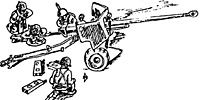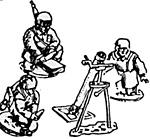
Second platoon was concealed, in a copse of woods alongside the road leading to Brugville. They watched as the German recon unit moved forward along the road leapf'rogging, first the kubelwagon, then the motorcycle combo in the lead. Second platoon's orders werc to let recon units move past and be caught at the bridge 400 yards to their rear by the rest of B co. Sergeant Young hoped they would.
As the Kubelwagon leading was passing their position, it happened. First one shot, then the whole platoon opened up. The Germans were surprised, but not flat footed. They recovered and began to fire back, joined by the overmatching Motorcycle unit. In minutes it was over. The Kubel platoon was wiped out, the motorcycle unit damaged, but Second platoon had ceased to be a unit.
The above was the opening moves of a WWII game played with Command Decision. The spotting rules were given minor changes, and a "special order" set of rules/ tests were added. The special order rules should work with almost any WWII set, and with other periods as well. Oh yes, the Germans were forced to deploy some infantry and moved down the road to the bridge. The first try at crossing by a company covered by the Motorcycle unit was thrown back with losses. Then two fresh companies, supported by a Stug III, a machine gun and a mortar pushed across thc bridge to where thc rest of B Co. was concealed in some woods.
B Co, taking some losses, checked on their special orders ( Engage, then fall back ) and fell back rather than getting engaged in a prolonged fire light. Now the Germans were in sight of their objective, the town of Brugville. But it had taken them five hours. B Co. delaying tactics were working.
Following are the charts I used for the Special Orders and spotting, as well as a rearranged C.D. spotting chart, with standard C. D. values. I hope others will find them useful.
Special Orders: During a battle, particularly WWII or modern, forward elements can receive orders on how to respond to recon/ advance guard units of the enemy. The orders can vary from engage, engage at point blank range, engage and fall back, or even allow small units to pass. These rules are designed to fit into several periods and rule sets to model these battlefield orders and the troops response to them.
1. Orders to engage at some range other than maximum. We will divide the ranges into nine bands, with 9 being the closest, and 1 the most distant. The unit must roll each turn that the enemy is in range, and roll the range band number or higher each turn to hold fire. The die roll on a D- IO is modified as below: green-l; Trained-0; experienced +1; veteran +2; concealed in woods or hedges +1; concealed in buildings or bunkers +2; covered escape route +2.
 2. Orders to engage and then fall back will find the troops likely to both fire early and fall back early. They know they will get out of there so why not now? The orders must specify the range to engage, which will utilize the above die rolls, and modifiers to determine when the shooting starts, and the following procedure to determine time of departure. Each turn the enemy is in sight and in range of the enemies weapons roll your units morale level or less to stay. Each hit on your unit will add one to the die roll.
2. Orders to engage and then fall back will find the troops likely to both fire early and fall back early. They know they will get out of there so why not now? The orders must specify the range to engage, which will utilize the above die rolls, and modifiers to determine when the shooting starts, and the following procedure to determine time of departure. Each turn the enemy is in sight and in range of the enemies weapons roll your units morale level or less to stay. Each hit on your unit will add one to the die roll.
Yes it is possible to leave before you fire. This will reduce casualties. Orders to allow a recon or advance guard unit to pass your unit. This can include orders to fire after they pass, turning it into an ambush. Using a D10, roll below the distance to the closest unit in inches each turn that they are in your weapon range. Modify your die roll with the factors below: Green +1 Trained -0 Regular -1 Experienced -2 Veteran -3 Concealed in woods/hedges -I Concealed in buildings/behind walls -2 Other unit is more powerful +2
Of course if you are observed and fired you will return fire.
I have been using these rules in solo games and they add to the fog of battle nicely. It is difficult to get troops to hold fire unless they are good and in a good position.
Spotting Chart:
Spotting by Regular / Trained Infantry
Die roll equal to or less than X to spot at indicated range or less.
Field Art. or AA mount 88 count as vehicle.
Vehicles
-
Vehicle moving and firing in the open: Spotted out to 60"
Veh. moving / open 12 out to 30" / 10-30" to 60"
Veh. moving / cover 8 to 30" / 4 to 60"
Veh Stationary / open 8 to 30" / 4 to 60"
Veh. firing stationary / open 10-30" / 8 to 60"
Veh. firing cover 12 to 30" / 10 to 60"
Veh Stationary / cover 8 to 5" / 4 to 10" / 0 to 20"
Infantry and heavy weapons
-
In open / moving / firing 12 to 30"/ 10 to 60" / 10 to 30"
in open / moving 12 to 15"
in open / stationary 8 to 30" / 4 to 60"
in open / stationary 8 to 15" / 4 to 30" / 0 to 60"
in cover/firing 8 to 15" / 4 to 30" / 0 to 60"
in cover/moving 8 to 6" / 4 to 12" / 0 to 24"
in cover /stationary 8 to 2" / 4 to 4" / 0 to 8
Modifiers to Die Roll
-
Spotter Stationary -2
Veteran 1
AFV Spotting to front +3
AFV spotting to flank +6
Target is a Recon or FO stand stationary and prone. Spotting range is 1/2.
Back to MWAN #85 Table of Contents
© Copyright 1997 Hal Thinglum
This article appears in MagWeb (Magazine Web) on the Internet World Wide Web.
Other military history articles and gaming articles are available at http://www.magweb.com